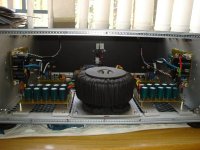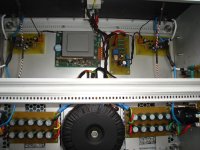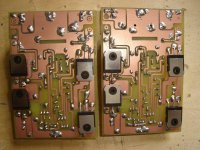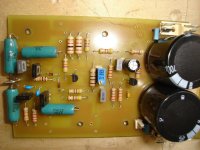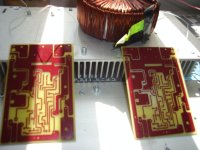So will you dish out the secrets then? Or is it just way too complicated to explain what modifications you do that provides 80% of the benefits above the stock amplifier? Don't gatekeep it if it really sounds amazing.But when I plug in one/my SE, the Hiraga only sounds like the solar system compared to the Galaxie: just the essentials. More like a model or symbolic representation of what is.
What SE models of amplifiers are you using for yourself?
Is there a thread where you go through the mods that you did to them so that I could read and get an idea?
I'm not decided on active crossovers yet although I'd like to explore it, but doing it with 4 channels of NC400 would not be worth the hassle and the costs in my opinion. The tweeter I have sounds amazing and if I connect it straight to amp - everything above 1500kHz is gonna sound unbelievable, then it's going to be entirely up to the amp and DAC. 1500kHz and bellow may not be the best drivers in the world, B&W 7 series would likely be nicer, but the combo will still definitely reveal what the amplification has to offer. You make a fair point about coherency and homogeneity. But I think I would rather sacrifice some homogeneity for the world-class bass of NC400 and also I'd like to compare modulus 86 to NC400 between each other. If I go more in your direction and try to create magic with SE, I'll probably keep it passive and focus on a good DAC before going active, but there's REAL gains in good cabling straight to the driver. I don't even know if amplification itself necessarily could provide something like that. Definitely more clarity, more insight and nuance, but I don't know about the same level of DRIVE and energy and ALIVENESS... Immediacy. Attention-grabbiness.
Last edited:
The best project you can do is P101 by Elliot sound.
Buy the pcbs and assemble the components. Apart from using lateral mosfets, it is a simple project that is guaranteed to work and sounds very good.
I would use the Exicon lateral mosfets that are available in profusionplc.
https://www.google.com/url?sa=t&sou...wQFnoECBYQAQ&usg=AOvVaw0McpHih5xGzjlPJwO8gSu8
Buy the pcbs and assemble the components. Apart from using lateral mosfets, it is a simple project that is guaranteed to work and sounds very good.
I would use the Exicon lateral mosfets that are available in profusionplc.
https://www.google.com/url?sa=t&sou...wQFnoECBYQAQ&usg=AOvVaw0McpHih5xGzjlPJwO8gSu8
So will you dish out the secrets then?
https://www.diyaudio.com/community/threads/hiraga-le-monstre-2024.413301/
https://www.diyaudio.com/community/threads/nad-302-recapping-the-220-volt-version.368883/
Someday I will revise and document the PA-940 and share it here. 😉
Of the three, which one is the most enjoyable for you and which one would you say is the most hi-fi after reworking it? All three are push pull, which you say isn't for Hi-Fi audio applications... I understand you probably use completely custom design for yourself, but is there anything that is available used that could be worked on and improved towards something closer to what you have at home?
Also, cumbb, may I have a private chat with you please?
Also, cumbb, may I have a private chat with you please?
I strongly advise to start with a consumer pp: you can start listening immediately, you can start modifying straight away, so you can immediately notice the audible differences. And they are initially in the range that you are used to hearing. It is also about the development of the ear and the audio-allocation of, for example, parts, setups, materials, concepts (circuits). The NAD and the PA-940 are excellent for this. A Hiraga is only available as "Classe A" https://www.disquantique.fr/materiel-vendu-ou-en-recherche-67/ampli-de-puissance-hiraga-classe-a-996 . It is like Le Monstre. It has the same problems and possibilities and sounds almost the same.Of the three, which one is the most enjoyable for you and which one would you say is the most hi-fi after reworking it? All three are push pull, which you say isn't for Hi-Fi audio applications... I understand you probably use completely custom design for yourself, but is there anything that is available used that could be worked on and improved towards something closer to what you have at home?
Also, cumbb, may I have a private chat with you please?
I would look for an SE such as First Watt or a small Aleph. Probably here in the forum, or on ebay.
Or for tube amplifiers. They have an even greater fascination than a transistor. Tube PPs sound great. SE tubes are unique. All here in the forum too. Or a very simple cheap China tube amp. 300 euros;-)
I couldn't say more in a private chat than here. Just write;-)
Well, sir, I wanted to offer to send you the Tandberg 3026A that I have (shipping cost on me if it's not too outrageous), that is partially burned, because I think you would not only diagnose it easily, but also would probably know what to do with it to make it sound good (assuming you are located in Germany). And if you have no interest in it's sound, you can probably use the fairly good power supply or chassis or something since you seem to enjoy playing with new projects. It is TO-3 so maybe you don't care about that at all (but wouldn't be too hard to install other packages either), but anyway, I'm also offering this to win some favor with you, because I want to learn more, but I understand that you may not have time to reply to all the questions of some rando on the internet.
Your recommendations are pretty clear. Yes I should probably start with consumer PP. Then, once I have a system that I have fully set up and that I am able enjoy, I can look further either into something like Aleph or tubes and take my sweet time with that, exploring it bit by bit, not necessarily too eager to arrive at a final solution all at once.
One more question I have is if I could perhaps buy your build of Hiraga or something else (assuming you have some other projects you don't necessarily care to listen to yourself) that you may not necessarily care to listen to yourself, but which perhaps still sounds more fun and interesting than many commercially available options.
Your documentation of PA 940 modifications like you did for NAD would be very appreciated if I end up buying it. Kinda tempted to go with NAD just to have a clearer idea of what to do.
I also wanted to come visit for a few hours or a day to hear and learn more what you have, but I don't know what would be a fair exchange for that. I would be nevertheless very curious to hear it myself.
Your recommendations are pretty clear. Yes I should probably start with consumer PP. Then, once I have a system that I have fully set up and that I am able enjoy, I can look further either into something like Aleph or tubes and take my sweet time with that, exploring it bit by bit, not necessarily too eager to arrive at a final solution all at once.
One more question I have is if I could perhaps buy your build of Hiraga or something else (assuming you have some other projects you don't necessarily care to listen to yourself) that you may not necessarily care to listen to yourself, but which perhaps still sounds more fun and interesting than many commercially available options.
Your documentation of PA 940 modifications like you did for NAD would be very appreciated if I end up buying it. Kinda tempted to go with NAD just to have a clearer idea of what to do.
I also wanted to come visit for a few hours or a day to hear and learn more what you have, but I don't know what would be a fair exchange for that. I would be nevertheless very curious to hear it myself.
Repairing the Tandberg would probably be possible, but it will never sound good)-;
On the one hand, I would be happy to visit and listen to music and exchange experiences, but on the other hand, I am practically homeless. I can only stay at my home for 1 - 2 hours: Environmental toxins. I will probably have to move out again.
And I still have a friend's CD player here, which I finally have to refurbish after two years. That alone will take me weeks)-;
But as I've already written: do it yourself audio is the greatest fun and gain in sound and expertise 😉
On the one hand, I would be happy to visit and listen to music and exchange experiences, but on the other hand, I am practically homeless. I can only stay at my home for 1 - 2 hours: Environmental toxins. I will probably have to move out again.
And I still have a friend's CD player here, which I finally have to refurbish after two years. That alone will take me weeks)-;
But as I've already written: do it yourself audio is the greatest fun and gain in sound and expertise 😉
Attachments
If you are only able to be home for 1-2 hours, that's not enough time to even sleep. Damn, tough gig, man.
If finances is an issue you could repair the Tandberg and quite easily sell it, people do want those amps and are willing to pay. But yes, the design is rather complicated there.
Environmental toxins could be interpreted in many ways... But damn, if you can't stay home you can't even listen to music.... Sorry to hear that. I wish that you find yourself in a more favorable situation soon 🙏🏼
Maybe some time later there would be more capabilities for you to arrange a listening session together. Really would love to hear your creations and perhaps learn a thing or two about how you do it.
What about selling one of your own amps? Is that feasible?
If finances is an issue you could repair the Tandberg and quite easily sell it, people do want those amps and are willing to pay. But yes, the design is rather complicated there.
Environmental toxins could be interpreted in many ways... But damn, if you can't stay home you can't even listen to music.... Sorry to hear that. I wish that you find yourself in a more favorable situation soon 🙏🏼
Maybe some time later there would be more capabilities for you to arrange a listening session together. Really would love to hear your creations and perhaps learn a thing or two about how you do it.
What about selling one of your own amps? Is that feasible?
I'm thinking about it;-)
I still have a Harman Kardon Citation 12, which I bought defective. One of the previous owners sprayed it bronze. I repaired it, but it sounded... well, you can't listen music with a Citation 12;-)-; Then I took out everything except the transformers and capacitors, took two old complementary pairs (TO-3 - because of heatsinks) and put in a pp-"follower"-) But this one is not finished yet. And it's not here either, it's "mothballed"-) Unfortunately, the transformers are not heavy-duty and neither are the heat sinks: not enough for Single Ended)-;
So that would be a 1-stage complementary transistor PP follower, half wave symmetric, made of only 4 parts per half-wave. That's an announcement - it couldn't be simpler hardly;-) It has a "double mono" psu. Strictly speaking, there are 4 power supplies, as each channel is two half-wave amplifiers and each half-wave has its own power supply. Then I installed a switch that can connect these channel-separated "double mono" psus together - 4 to 2 to be precise. As a gag, so that everyone can switch back and forth until the ears smoke and hear the difference between "channel-separated" psus and one psu. Until it "clicks" in the head: the untested nonsense and bad sound of "dual mono" psus;-) And the proof that identical parts sound different, on which almost the entire audio, hi-fi, high-end discourse can be built;-)
A follower does not amplify voltage. It only makes current. As a tip: a headphone output, headphone amplifier or DAC is sufficient to bring a follower up to max about party volume. You can't get any louder! A follower also sounds very different from an amplifier: milder, smoother, creamy, finely colored. Only twice have I managed to build an amplifier (from the same parts, i.e. simply rebuilt) that sounded slightly cleaner than the follower. A follower doesn't need feedback either.
The sound of this device is limited by the TO-3 transistors. This device is built for looks too. Give me 2 or 3 weeks to get it and photograph. If you haven't found anything good amp in the meantime, I'll send it to you and you'll hear. And if you like it, if it fits to your speakers and source devices, including the max volume, then... the price I send per private - the price I paid for the defective device only.
Maybe you could come when the weather is cooler again, then maybe the toxins here are less. (Aside: I do sleep not in here. In a kitchen of a friend or in a garden...-)
I still have a Harman Kardon Citation 12, which I bought defective. One of the previous owners sprayed it bronze. I repaired it, but it sounded... well, you can't listen music with a Citation 12;-)-; Then I took out everything except the transformers and capacitors, took two old complementary pairs (TO-3 - because of heatsinks) and put in a pp-"follower"-) But this one is not finished yet. And it's not here either, it's "mothballed"-) Unfortunately, the transformers are not heavy-duty and neither are the heat sinks: not enough for Single Ended)-;
So that would be a 1-stage complementary transistor PP follower, half wave symmetric, made of only 4 parts per half-wave. That's an announcement - it couldn't be simpler hardly;-) It has a "double mono" psu. Strictly speaking, there are 4 power supplies, as each channel is two half-wave amplifiers and each half-wave has its own power supply. Then I installed a switch that can connect these channel-separated "double mono" psus together - 4 to 2 to be precise. As a gag, so that everyone can switch back and forth until the ears smoke and hear the difference between "channel-separated" psus and one psu. Until it "clicks" in the head: the untested nonsense and bad sound of "dual mono" psus;-) And the proof that identical parts sound different, on which almost the entire audio, hi-fi, high-end discourse can be built;-)
A follower does not amplify voltage. It only makes current. As a tip: a headphone output, headphone amplifier or DAC is sufficient to bring a follower up to max about party volume. You can't get any louder! A follower also sounds very different from an amplifier: milder, smoother, creamy, finely colored. Only twice have I managed to build an amplifier (from the same parts, i.e. simply rebuilt) that sounded slightly cleaner than the follower. A follower doesn't need feedback either.
The sound of this device is limited by the TO-3 transistors. This device is built for looks too. Give me 2 or 3 weeks to get it and photograph. If you haven't found anything good amp in the meantime, I'll send it to you and you'll hear. And if you like it, if it fits to your speakers and source devices, including the max volume, then... the price I send per private - the price I paid for the defective device only.
Maybe you could come when the weather is cooler again, then maybe the toxins here are less. (Aside: I do sleep not in here. In a kitchen of a friend or in a garden...-)
Your offer is highly interesting to me! In the mean time I would be looking for a NAD 302 and then try and follow your steps and see what the different changes do to the sound and what could be the final result. If nothing else - use it as a preamp or for the phono stage. Don't know where to source TO-126 yet, but everything else I should find locally.I'm thinking about it;-)
Here is the good one;-)
Bronze from a previous owner.
Basically we see the PP circuit, arranged like a boxer engine. 2 channels. And we can also see all the components involved, two TO-3 transistors per channel, two power resistors per channel, two diodes per channel and two small resistors that define the drive current. I also have different power transistors (values) to customize the sound of the amplifier.
I had also ordered, had got a copper plate to cover the area between the power supply and the amplifier. This copper plate would also contain the switch for the power supply connection.
Various screws/nuts can be seen on the transistors. At the time, I was looking at the appearance: what material and shape might be appropriate. I also still have gray plastic screws with which I wanted to fasten the transistors - then countered with stainless steel or brass cap nuts, for example.
These devices do not have a power switch. They ran via the preamp stage. It is also not clear which side you turn to the front. I wanted to swap the mains cable with the lamp.
Size: 33 cm x 33 cm x 14 cm. 11,2 kg.
Bronze from a previous owner.
Basically we see the PP circuit, arranged like a boxer engine. 2 channels. And we can also see all the components involved, two TO-3 transistors per channel, two power resistors per channel, two diodes per channel and two small resistors that define the drive current. I also have different power transistors (values) to customize the sound of the amplifier.
I had also ordered, had got a copper plate to cover the area between the power supply and the amplifier. This copper plate would also contain the switch for the power supply connection.
Various screws/nuts can be seen on the transistors. At the time, I was looking at the appearance: what material and shape might be appropriate. I also still have gray plastic screws with which I wanted to fasten the transistors - then countered with stainless steel or brass cap nuts, for example.
These devices do not have a power switch. They ran via the preamp stage. It is also not clear which side you turn to the front. I wanted to swap the mains cable with the lamp.
Size: 33 cm x 33 cm x 14 cm. 11,2 kg.
Attachments
-
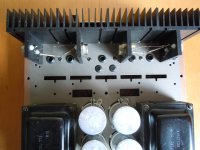 DSCN0531.JPG434.1 KB · Views: 80
DSCN0531.JPG434.1 KB · Views: 80 -
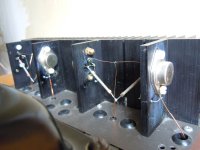 DSCN0530.JPG337.6 KB · Views: 80
DSCN0530.JPG337.6 KB · Views: 80 -
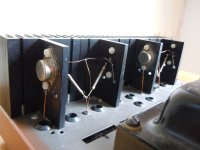 DSCN0529.JPG321.8 KB · Views: 90
DSCN0529.JPG321.8 KB · Views: 90 -
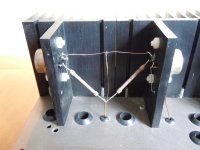 DSCN0528.JPG413 KB · Views: 80
DSCN0528.JPG413 KB · Views: 80 -
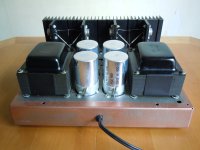 DSCN0526.JPG371.3 KB · Views: 82
DSCN0526.JPG371.3 KB · Views: 82 -
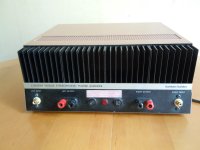 DSCN0523.JPG319.8 KB · Views: 84
DSCN0523.JPG319.8 KB · Views: 84 -
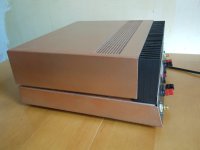 DSCN0522.JPG295 KB · Views: 76
DSCN0522.JPG295 KB · Views: 76 -
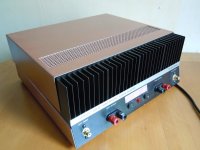 DSCN0521.JPG350.5 KB · Views: 82
DSCN0521.JPG350.5 KB · Views: 82 -
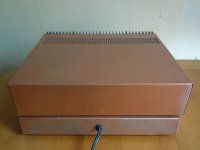 DSCN0520.JPG321 KB · Views: 78
DSCN0520.JPG321 KB · Views: 78 -
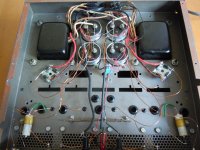 DSCN0524.JPG569.6 KB · Views: 77
DSCN0524.JPG569.6 KB · Views: 77
Got my hands on a NAD 302. This thing is light as hell. Unironically it also sounds light, there's not much power in low end at any volume level. But I do hear potential in general. Some weird high frequency pitch is present though it seems, I don't know, high frequencies sound weird, mids are pretty hollow too somehow. Female voices seem to be there, but lower voices disappear a bit. Everything is kind of in your throat and in your head while Tandberg was also in your chest and also had a good low end that was powerful even if not nearly as precise and quick and present as Class D. Strange little amp, but I'm not saying it doesn't have something to it. Since the lighthanded bass and mids it sounds bright. Also where bass is more intense it seems to start seriously messing up the mids and the rest... High female voices do sound interesting, but the upper treble is either rolled off or mushed. High frequencies in general sound very unconvincing, some more nuanced and quieter sounds or entire notes seem to be missing. As if the melody didn't contain them, but I know the song - they're there! In general I'd describe Tandberg as MUCH more rich pretty much in every frequency range. Got some Panasonic caps 220uF and 100 uF. And I ordered the TO-126 power transistors as well.
Last edited:
- Home
- Amplifiers
- Solid State
- Biggest bang for your buck lateral MOSFET projects in the last 5 years
